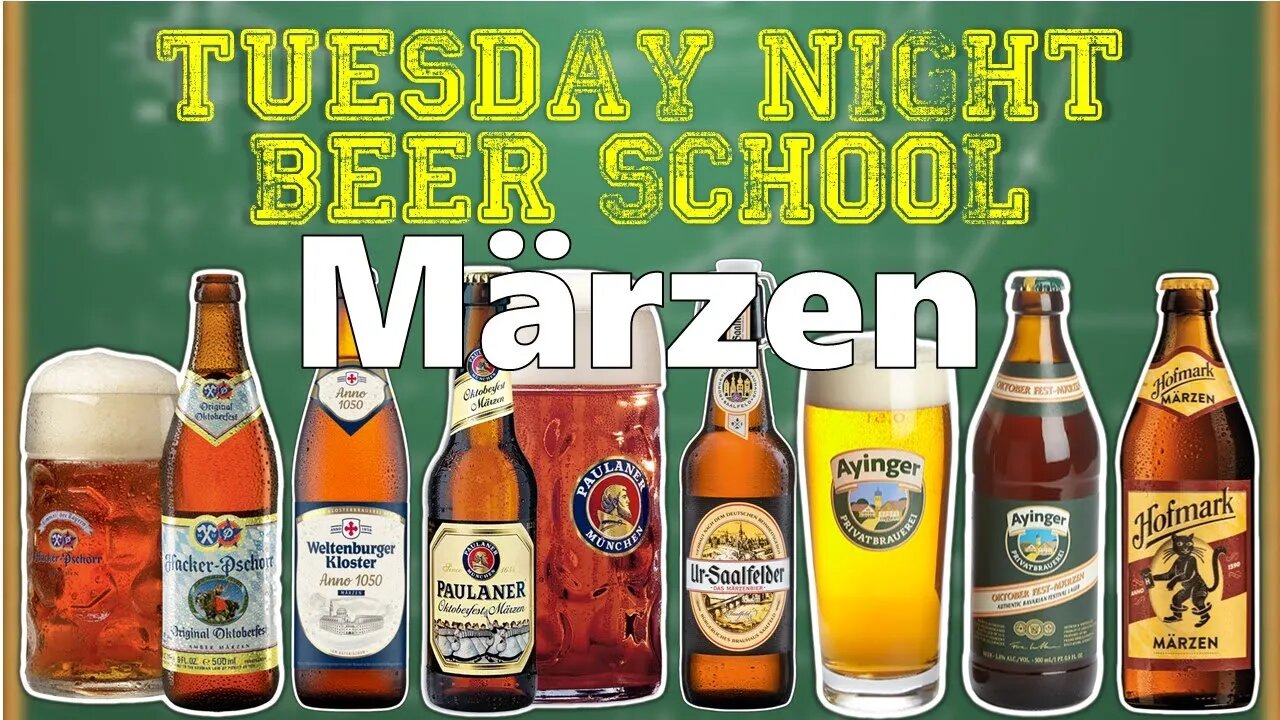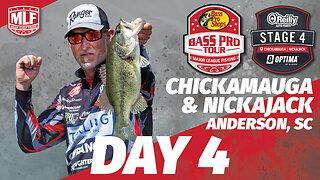Premium Only Content

𝗧𝘂𝗲𝘀𝗱𝗮𝘆 𝗡𝗶𝗴𝗵𝘁 𝗕𝗲𝗲𝗿🍺 𝗦𝗰𝗵𝗼𝗼𝗹: Märzen (Germany🇩🇪 vs. USA🇺🇸)
When most Americans think "Oktoberfest Beer" they probably think of a copper/reddish lager with a toasty/caramel palette. That style is better known as Märzen in its home country of Germany. These beers were originally brewed in March and cellared in caves throughout the summer and then drank in the fall as the original Oktoberfest brew(which has since been replaced by Festbier; a completely separate style which you can learn about here: https://youtu.be/olvw7_v3TG4)
Cristina joins me again to analyze four popular examples of style and just like we did with Festbier, we had two flights of authentic German examples versus two contemporary American examples:
ROUND 1: Ayinger Oktoberfest-Märzen versus Bell's Octoberfest
ROUND 2: Hacker-Pschorr Oktoberfest-Märzen versus Yuengling Octoberfest
From the 2021 𝓑𝓙𝓒𝓟 𝓢𝓽𝔂𝓵𝓮 𝓖𝓾𝓲𝓭𝓮𝓵𝓲𝓷𝓮𝓼:
6A. Märzen
𝗢𝘃𝗲𝗿𝗮𝗹𝗹 𝗜𝗺𝗽𝗿𝗲𝘀𝘀𝗶𝗼𝗻: An amber, malty German lager with a clean, rich, toasty, bready malt flavor, restrained bitterness, and a well-attenuated finish. The overall malt impression is soft, elegant, and complex, with a rich malty aftertaste that is never cloying or heavy.
𝗔𝗿𝗼𝗺𝗮: Moderate malty aroma, typically rich, bready, somewhat toasty, with light bread crust notes. Clean lager fermentation character. Very low floral, herbal, or spicy hop aroma optional. Caramel-sweet, biscuity-dry, or roasted malt aromas are inappropriate. Very light alcohol might be detected, but should never be sharp. Clean, elegant malt richness should be the primary aroma.
𝗔𝗽𝗽𝗲𝗮𝗿𝗮𝗻𝗰𝗲: Amber-orange to deep reddish-copper color; should not be golden. Bright clarity, with persistent, off-white foam stand.
𝗙𝗹𝗮𝘃𝗼𝗿: Moderate to high rich malt flavor often initially suggests sweetness, but the finish is moderately-dry to dry. Distinctive and complex maltiness often includes a bready, toasty aspect. Hop bitterness is moderate, and the floral, herbal, or spicy hop flavor is low to none. Hops provide
sufficient balance that the malty palate and finish do not seem sweet. The aftertaste is malty, with the same elegant, rich malt flavors lingering. Noticeable sweet caramel, dry biscuit, or roasted flavors are inappropriate. Clean fermentation profile.
𝗠𝗼𝘂𝘁𝗵𝗳𝗲𝗲𝗹: Medium body, with a smooth, creamy texture that often suggests a fuller mouthfeel. Medium carbonation. Fully attenuated, without a sweet or cloying impression. May be slightly warming, but the strength should be relatively hidden.
𝗖𝗼𝗺𝗺𝗲𝗻𝘁𝘀: Modern domestic German Oktoberfest versions are golden – see the Festbier style for this version. Export German versions (to the United States, at least) are typically orange-amber in color, have a distinctive toasty malt character, and are often labeled Oktoberfest. Many craft versions of Oktoberfest are based on this style. Historic versions of the beer tended to be darker, towards the brown color range, but there have been many ‘shades’ of Märzen (when the name is
used as a strength); this style description specifically refers to the stronger amber lager version. The modern Festbier can be thought of as a lighter-bodied, pale Märzen by these terms.
𝗛𝗶𝘀𝘁𝗼𝗿𝘆: As the name suggests, brewed as a stronger “March beer” in March and lagered in cold caves over the summer. Modern versions trace back to the lager developed by Spaten in 1841, contemporaneous to the development of Vienna lager. However, the Märzen name is much older than 1841 – the early ones were dark brown, and the name implied a strength band (14 °P) rather than a style. The amber lager style served at Oktoberfest from 1872 until 1990 when the golden Festbier was adopted as the standard festival beer.
𝗖𝗵𝗮𝗿𝗮𝗰𝘁𝗲𝗿𝗶𝘀𝘁𝗶𝗰 𝗜𝗻𝗴𝗿𝗲𝗱𝗶𝗲𝗻𝘁𝘀: Grist varies, although traditional German versions emphasized Munich malt. The notion of elegance is derived from the finest quality ingredients, particularly the base malts. A decoction mash is traditional, and enhances the rich malt profile.
𝗦𝘁𝘆𝗹𝗲 𝗖𝗼𝗺𝗽𝗮𝗿𝗶𝘀𝗼𝗻: Not as strong and rich as a Dunkles Bock. More malt depth and richness than a Festbier, with a heavier body and slightly less hops. Less hoppy but equally malty as a Czech Amber Lager, but with a different malt profile.
𝗩𝗶𝘁𝗮𝗹 𝗦𝘁𝗮𝘁𝗶𝘀𝘁𝗶𝗰𝘀: OG: 1.054 – 1.060
IBUs: 18 – 24 FG: 1.010 – 1.014
SRM: 8 – 17 ABV: 5.6 – 6.3%
𝗖𝗼𝗺𝗺𝗲𝗿𝗰𝗶𝗮𝗹 𝗘𝘅𝗮𝗺𝗽𝗹𝗲𝘀: Hacker-Pschorr Oktoberfest Märzen, Hofmark Märzen, Paulaner Oktoberfest, Saalfelder Ur-Saalfelder, Weltenburger Kloster Anno 1050
𝗧𝗮𝗴𝘀: standard-strength, amber-color, bottom-fermented, lagered, central-europe, traditional-style, amber-lager-family, malty
#chadzbeerreviews #tuesdaynightbeerschool #marzen #märzen #oktoberfest #oktoberfestbier #festbier #germanbeer #germanlager #bier #craftlager #lager #paulaner #hackerpschorr #bellsbrewery #yuengling #weltenburger #octoberfest #BJCP #cicerone #beerjudging #beer #beerreview #craftbeer #beersnob #craftbeernerd #beergeek
-
 2:51:57
2:51:57
vivafrei
17 hours agoEp. 262: Shiloh is COINTELPRO 2.0? The "Woke Right"? Trump's Ukraine, Iran Deal! Canada Stuff & MORE
143K193 -
 1:52:05
1:52:05
IsaiahLCarter
16 hours ago $3.78 earnedAPOSTATE RADIO #013: Congestion Pricing is For The Dogs (feat. Charlie Panoff, Danny Perlstein)
37.8K13 -
 1:52:17
1:52:17
KINGKILLJ0Y
7 hours agoWhen it's DARK....it's time for RANK! //🔴LIVE
33.9K5 -
 2:06:49
2:06:49
Tundra Tactical
9 hours ago $9.39 earnedStar Wars Blaster Rankings and Other Galactic Gun News On The Galaxies Okayest Gun Live Stream
47.7K3 -
 2:09:29
2:09:29
Nerdrotic
11 hours ago $18.18 earnedAncient Precision Stone Vases Discoveries | Forbidden Frontier 100
79K10 -
 5:44:01
5:44:01
EricJohnPizzaArtist
9 hours agoAwesome Sauce PIZZA ART LIVE Ep. #46: Celebrating ONE YEAR on RUMBLE and Star Wars Day!
61.7K5 -
 6:53:09
6:53:09
iCheapshot
9 hours ago $3.77 earnedSunday Funday | Warzone Vibes
33.6K5 -
 54:50
54:50
Sarah Westall
10 hours agoTwo States Start Criminal Investigations against Fauci and Friends w/ Attorney Rachel Rodriguez
52K55 -
 3:15:51
3:15:51
BubbaSZN
7 hours ago🔴 LIVE - BACK TO RACING IN MEXICO (FORZA HORIZON 5)
18.8K1 -
 LIVE
LIVE
Major League Fishing
6 days agoLIVE! - Bass Pro Tour: Stage 4 - Day 4
1,984 watching